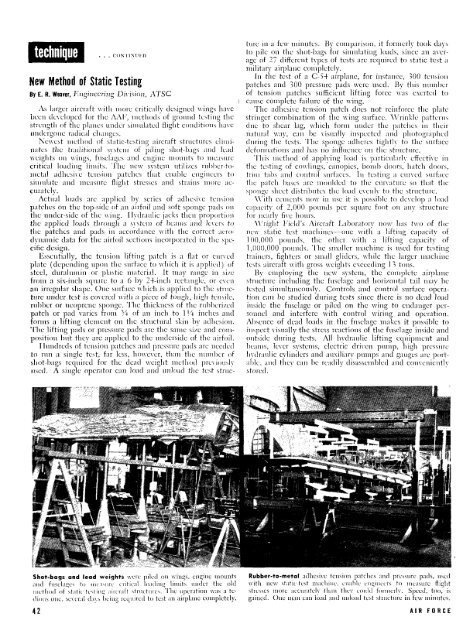Air Force the Official Service Journal - Air Force Historical Studies ...
Air Force the Official Service Journal - Air Force Historical Studies ...
Air Force the Official Service Journal - Air Force Historical Studies ...
You also want an ePaper? Increase the reach of your titles
YUMPU automatically turns print PDFs into web optimized ePapers that Google loves.
technique •••<br />
CO]\;Tl:"UED<br />
New Method of Static Testing<br />
By E. R. Weaver, Fuginccring Di\'ision, ATSC<br />
As larger aircraft with more criticallv designed wings have<br />
been developed for <strong>the</strong> AAF, methods of ground testing <strong>the</strong><br />
strength of <strong>the</strong> planes under simulated flight conditions have<br />
undergone radical changes.<br />
1'\e\\est method of static-testing aircruft structures climina<br />
tes <strong>the</strong> tradition;!! S~'stclll of pil ing shot-hags ;llId 1c;!d<br />
,,'eights on \\'ings, fuselages and engine mounts to measure<br />
critical loading limits. The new system ntilizcs rubber-tometal<br />
adhesive tcnsiou patches that enable engiueers to<br />
simulate and measure flight stresses and strains more accurately.<br />
Actt;al loads arc appl icd by series of adhesive tension<br />
patches on <strong>the</strong> top-side of an airfoil and soft sponge pads on<br />
<strong>the</strong> under-side of <strong>the</strong> \\iug. l Ivclranlic jacks <strong>the</strong>n proportion<br />
<strong>the</strong> applied loads through a system of heams and 1cn:rs to<br />
<strong>the</strong> patches and pads in accordance with <strong>the</strong> correct aerodynamic<br />
data for <strong>the</strong> airfoil sections incorporated in <strong>the</strong> specific<br />
design.<br />
Essentially, <strong>the</strong> tension lifting patch is a flat or curved<br />
plate (depending upon <strong>the</strong> surface to which it is applied) of<br />
steel, dural um in or plastic material. It may range in xi:«:<br />
from a. six-inch square to a 6 hy 24-ineh rectangle, or even<br />
an irregular shape. One surface which is applied to <strong>the</strong> structure<br />
under test is covered with a piece of tough, high te!lSile,<br />
rubber or neoprenc sponge. The thickness of <strong>the</strong> ruhberized<br />
patch or pad varies from YI of an inch to I ~~ inches and<br />
forms a lifting element on <strong>the</strong> structural skin by adhesion.<br />
'The lifting pads or pressurc pads arc <strong>the</strong> same size and composition<br />
hut <strong>the</strong>y arc applied to <strong>the</strong> underside of <strong>the</strong> airfoil.<br />
II und reds of tension pa tchcs and pressure pads arc needed<br />
to run a single test, far less, however, than <strong>the</strong> number of<br />
shot-hags required for <strong>the</strong> dead \\'eight method prcviouslv<br />
used. A single operator can load and unload <strong>the</strong> test struc-<br />
Shot-bags and lead weights were piled on wings. cn!;ine mounts<br />
and f11ScL1~cs to UW:l'\UT critical lO:ldin~ limits unclcr <strong>the</strong> old<br />
mot lrocl of .,t;\tic tnt iu~ .iirrr.rf t struct urc-. The operation was a tedious<br />
one, several da\s heing required to test an airplane completely.<br />
42<br />
turc in a few minutes. By comparison, it formerly took days<br />
to pile on <strong>the</strong> shot-hags for simulating loads, since an average<br />
of 27 different tvpcs of tests arc required to static test a<br />
military airplane completely.<br />
In <strong>the</strong> test of a C- 54 airplane, for instance, 300 tension<br />
patches and 300 pressurc pads were used. By this number<br />
of tension patches sufficient lifting forcc was exerted to<br />
cause complete failure of <strong>the</strong> wing.<br />
The adhesive tension patch docs not reinforce <strong>the</strong> plate<br />
stringer combination of <strong>the</strong> wing surface. \Vrinkle patterns<br />
clue to shear lag, which form under <strong>the</strong> patches in <strong>the</strong>ir<br />
natural ,,'ay, can be visunlly inspected and photogmphed<br />
during <strong>the</strong> tests. The sponge adheres tighth' to <strong>the</strong> surface<br />
deforlllations anc] has no influence on <strong>the</strong> structure.<br />
This method of appl~'ing load is purticul.ulv effective in<br />
<strong>the</strong> testing of cmdings, canopies, bomb doors, hatch doors,<br />
trim tubs and control surfaces. In testing a curved surface<br />
<strong>the</strong> patch bases arc moulded to <strong>the</strong> curvature so that <strong>the</strong><br />
sponge sheet distributes <strong>the</strong> load cvcnlv to <strong>the</strong> structure.<br />
\\'ith cements now in usc it is possible to develop a load<br />
c.rpacitv of 2,000 pounds per square foot on any structure<br />
for nearly fi\"Chours.<br />
\\'rig!;t held's <strong>Air</strong>craft LilJOratory 110\1' has tIHI of <strong>the</strong><br />
new static test machincs-one with a lifting capacity of<br />
100,000 pounds, <strong>the</strong> o<strong>the</strong>r with a lifting capacity of<br />
1,000,000 pounds. The smaller machine is used for testing<br />
trainers, fighters or small glidcrs, while <strong>the</strong> larger machine<br />
tests aircraft with gross wcights cxcccd ing 1"3tons.<br />
By employing <strong>the</strong> new system, <strong>the</strong> complete airplane<br />
structure including <strong>the</strong> fuselage and horizontal tail lIlay be<br />
tested simultaneously. Controls and control surface operation<br />
em he studied during tests since <strong>the</strong>re is no dead load<br />
inside <strong>the</strong> fuselage or piled on <strong>the</strong> wing to endanger personnel<br />
and interfere with control ,,'iring and operation.<br />
Absence of dead loads in <strong>the</strong> fuselage 111akcs it possible to<br />
inspect visually <strong>the</strong> stress reactions of <strong>the</strong> fuschge inside and<br />
outside during tests. All hydraulic lifting equipment and<br />
beams, lever systems, electric dr ivcn pump, high press nrc<br />
hvdr.iulic cylinders and auxiliary pumps and gaugcs arc portable.<br />
and thcv can he rcnclilv disassembled and couvc nicntlv<br />
stcnee!. . .<br />
Rubber-to-metal adhesive tension patches and prcssure pads, used<br />
with new stat ir-t cst machine, enable ell~illeers to measure flight<br />
stresses more .iccuratclv rh.ru thcv could for nu.rlv. Speed, too, is<br />
gained. One m.ui can load .md unload test structure in few minutes.<br />
AIR FORCE
















